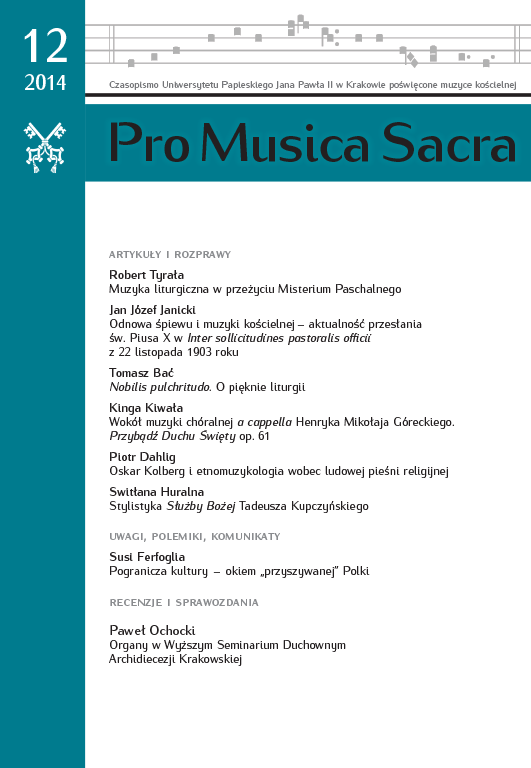Polska twórczość organowa zainspirowana pieśnią kościelną w liturgii Kościoła rzymskokatolickiego, cz. I
Polish organ music inspired by church songs in the Catholic liturgy, part I
Author(s): Witold ZalewskiSubject(s): Christian Theology and Religion, Music
Published by: Wydawnictwo Naukowe Uniwersytetu Papieskiego Jana Pawła II w Krakowie
Keywords: Music; organ music; music in the liturgy; organ preludes; liturgical music;
Summary/Abstract: The knowledge of organ literature devoted to native composers leaves much to be desired. If they even perform solo organ music at liturgy, contemporary church organists often reach for the works of grand European masters, forgetting about the Polish reservoir of sacral pieces. An old proverb “the grass is greener on the other side of the fence” is an accurate description of the state of knowledge of young (and the older) organists on Polish organ music. Why is therefore Polish sacral organ literature so important for the contemporary church musician? Most importantly because, in the Roman Catholic church liturgy, “compositions based on church songs shall (i.e. are) desirable”. As early as in the 16th century, church song was used by the Polish composers as the melodic material for the organ pieces they composed. The first church compositions were created through adapting vocal pieces to the purposes of key music. Some of the most prominent examples include e.g. 16th-century Polish music monuments – John of Lublin Tabulator of 1540, The Saint Ghost Monastery Tabulator of 1548 and the Warsaw Music Society Tabulator from approx. 1580. The turn of the 18th and the 19th century in Europe and in Poland displays a secularization of organ music, influenced by the spread of the Naples school. Secular and opera elements influence church music, which gradually develops utilitarian properties. It is worth to remember that the Polish religious oeuvre is the contribution of Polish organists-virtuosos, often great improvisers, with extensive professional practice. The first creators of this literature were church organists, active on many a musical platform, composers, organizers of music life and university professors. This family of authors includes: Władysław Żeleński, Stefan Surzyński, Mieczysław Surzyński, Feliks Nowowiejski, Walenty Dec, Wincenty Rychling, Kazimierz Garbusiński, Feliks Rączkowski, Józef Furmanik, as well as the following priests: Gustaw Roguski, Józef Surzyński, Franciszek Walczyński, Antoni Chlondowski, or Idzi Ogierman-Mański. Also contemporary organists, such as Marian Sawa, Tadeusz Machl, or Jan Janca have been composing in this spirit. The author of this publication attempts at presenting the Polish organ music oeuvre, to be applied in the Roman Catholic church liturgy. Performing a division into applied music (as presented in the 1st part of the article) and concert music, the artist is aware that “we cannot make a precise classification into applied music (both didactic and church music) and concert music, since applied pieces contain numerous elaborate forms with grand artistic ambitions, played both in church and in the concert room”. Due to the specific character and sometimes not the top-notch artistic rank, organ music surely has as many advocates as it has opponents. Most of all, it will surely be found useful by church musicians who are less advanced in organ play and the art of improvisation, who seek support in the form of short, non-complex pieces applied in the postcouncil Roman Catholic liturgy.
Journal: Pro Musica Sacra
- Issue Year: 12/2014
- Issue No: 12
- Page Range: 169-199
- Page Count: 31
- Language: Polish

